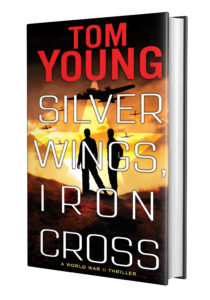Diving Into the Past for a Historical Novel
Twenty-six miles off Morehead City, NC, the dive boat pitched and rolled. I fought seasickness as I pulled on my scuba gear. Everything gets harder when you’re trying not to lose your lunch; even strapping on fins becomes a struggle. I screwed the regulator onto my air tank. Cracked open the valve and watched the pressure gauge spring to 3000 PSI. Finally, with mask, fins, weight belt, and everything else in place, I rolled over the side and splashed into the swells.
The seasickness went away as soon as I hit the water. I followed my buddy and the other divers down the anchor line. The water grew darker and the light dimmer as we descended. My eyes adjusted to the depth. Every few feet, I swallowed so that my ears would pop and adjust to the depth, as well.
She materialized as if a film director had ordered a dissolve to a new scene. On the bottom, at a depth of 110 feet, lay the U-352, a German submarine sunk by the U.S. Coast Guard cutter Icarus on May 9, 1942. Of her 48 crew members, 15 perished. The survivors spent the rest of the war as prisoners.
I explored the U-boat for every minute the time-depth tables allowed. Amid amberjack hovering around her conning tower, I tried to imagine the battle that sent her to the ocean floor. The hiss of air flowing through my regulator and into my lungs reminded me of my own frailty. If the regulator failed, my chest would start to burn for air in a place where none existed. It became very easy to imagine the terror a sailor might feel if trapped in that steel hull as it filled with water. (Click here for video of divers on the U-352.)
Suddenly the past was no longer a faraway country. It was something real, right there in front of me, and I wanted to know more. Decades after that dive, my interest in the WWII Battle of the Atlantic found expression in my novel Silver Wings, Iron Cross.
To write a historical thriller, you don’t have to go to such lengths—or depths, as the case may be. But along the way, I learned a few things about writing a novel set in a previous time.
There are plenty of ways to immerse yourself, if you’ll pardon the pun, in the past. You can do library research. You can read memoirs. You can watch old movies or listen to recordings of old radio broadcasts. If your time period is recent enough, you can interview people who were there. One practical tip: You can try to find a Sears catalog from your chosen time to get an idea of what people wore and how much things cost.
Admittedly, the farther back in time you go, the harder this job becomes. You won’t find a Sears catalog or a radio broadcast from the eighteenth century.
But what’s even more important is to find an emotional connection with your characters. When we novelists do our best work, we tap into something universal and timeless. Our protagonists long for home, fear death, need to prove themselves, or hope to save a life. Perhaps they seek to solve a crime, or prevent one. Maybe they aim to defend their countries or avenge a wrong. Perhaps they experience some combination of the above.
In this regard, a novelist lives in all times at once. Until you do the research, you might not know how to climb the rigging of a British man-of-war. But you can well imagine the fear if you made that climb with cannon fire scorching past you. You might not know, yet, how a farmer in 1863 grew tobacco. But you can relate to his worries when a draft notice from the Confederate Army pulls him from his fields and family.
For me, finding a relevant historic site or artifact helps prime the creative pump and make that emotional connection. History classes might teach you the futility of Pickett’s Charge. But go to Gettysburg and gaze out over that open field. Think of crossing it with no cover, under a storm of bullets. Your palms will sweat.
Visit an air museum and crawl through the cramped spaces of a B-17 Flying Fortress. Now imagine trying to bail out in heavy flying gear as the aircraft spirals toward the ground. Your heart will pound.
Find an arrowhead in a plowed field. Now put yourself in the place of a young Native American facing the approach of winter 10,000 years ago. You’ll pray to whatever God you believe in to let your arrow fly true and provide meat.
In a meditative moment at your writing desk, try to inhabit your character: If I were in this situation, what would I want? What would I fear? What would I say or do? The answers are not so far in the past as you might think.
William Faulkner famously wrote: “The past is never dead. It’s not even past.” To take the thought a little further, the past is all around us. And in our most basic fears, hopes, dreams, and aspirations, the past is also within us.

